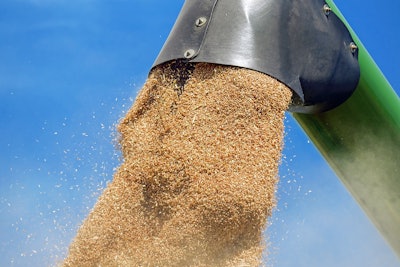
Transportation costs for U.S. grain shipped to Mexico presented a mixed picture in the first quarter of 2025, with declining waterborne rates for corn and soybeans contrasting with rising land transport costs for all three major grains, according to a May 22 report from the U.S. Department of Agriculture’s Agricultural Marketing Service (AMS). These fluctuations, coupled with changes in farm values, influenced landed costs and U.S. grain export volumes to the key market.
The AMS "Grain Transportation Report" detailed these changes:
Quarter-to-Quarter Transportation Costs (Q4 2024 to Q1 2025):
- Water Routes (to Veracruz):
- Total transportation costs for U.S. corn (Illinois origin) and soybeans (Illinois origin) both decreased by 3.1%. This was attributed to falling barge rates (down 14.4%) and ocean freight rates (down 8.1%).
- A significant 48% drop in soybean exports through the U.S. Gulf—from 15.1 million metric tons (mmt) in fourth quarter 2024 to 7.8 mmt in first quarter 2025—contributed to these declines, as reported by USDA’s Foreign Agricultural Service’s Global Agricultural Trade System (GATS).
- Lower ocean freight rates also reflected an ample supply of vessels and a seasonal demand lull due to global holidays, including the Chinese Lunar New Year.
- Transportation costs for waterborne wheat (Kansas origin) remained stable, decreasing by 0.1%.
- Land Routes (to U.S.-Mexico border):
- Total transportation costs rose for corn (Iowa origin, up 1.5%), soybeans (Missouri origin, up 1.6%), and wheat (Kansas origin, up 2.2%).
- These increases were primarily driven by higher truck rates, which rose 21.3% for all three grains from these origins. The AMS cited limited truck supply, strong trucking demand, and rising diesel prices as contributing factors. Rail rates for these movements saw slight decreases of 0.5% (corn and soybeans) and 0.3% (wheat).
Year-to-Year Transportation Costs (Q1 2024 to Q1 2025):
- Water Routes:
- Transportation costs for corn (Illinois origin) and soybeans (Illinois origin) both increased by 12.4%. This was mainly due to higher truck rates (up 34.6%) and barge rates (up 34.7%).
- The AMS noted that elevated barge rates stemmed from delays caused by winter storms, high water levels, lock repairs in the Mississippi River System, and increased export sales, especially for corn.
- Wheat transport costs by water (Kansas origin) fell by 4.4%, benefiting from a 29.8% decrease in ocean freight rates.
- Land Routes:
- Costs for soybeans (Missouri origin) decreased by 1.3% and wheat (Kansas origin) by 5.3%, attributed to lower rail tariff rates (down 2.6% for soybeans and 7.3% for wheat from these origins).
- Corn transportation costs via land routes (Iowa origin) remained relatively stable, increasing by 0.1%.
Landed Costs: Landed costs, which combine farm values with total transportation costs, also showed varied trends. Transportation accounted for 14% (soybeans) to 27% (corn) of landed costs for all routes and grains in the first quarter of 2025.
- Quarter-to-Quarter: Landed costs for corn and soybeans increased for both water and land routes. For waterborne shipments, rising farm values (e.g., Illinois corn +9.8%, Illinois soybeans +1.7%) outweighed falling transportation costs. For land routes, both farm values (e.g., Iowa corn +8.8%, Missouri soybeans +3.5%) and transportation costs rose. Landed costs for wheat were mostly unchanged.
- Year-to-Year: Landed costs generally fell for most grains and routes. The exception was corn shipped by water to Veracruz, where landed costs rose 4.1% year-over-year due to increases in both transportation costs and farm values. For other combinations, landed costs declined due to lower transportation costs and/or lower farm values; for instance, landed costs for soybeans via water to Veracruz fell 13.6%.
U.S. Exports to Mexico (Q1 2025): According to GATS data, U.S. grain exports to Mexico in the first quarter of 2025, and their changes, were as follows:
- Corn: 5.64 mmt, down 10% from the previous quarter and down 8% year-over-year.
- Soybeans: 1.16 mmt, down 31% from the previous quarter and down 16% year-over-year.
- Wheat: 0.103 mmt, up 14% from the previous quarter and up 7% year-over-year.
The AMS report underscored that Mexico is a major importer of U.S. grain, and competitive transportation and landed costs are vital for U.S. grain in both the Mexican and global markets.


















